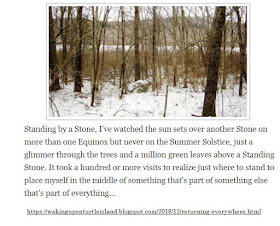Susan Allport Photo
Above: Still Capture from a video presentation of "Sermons in Stone: The Stone Walls of New England
and New York" - Susan Allsport (sic) by WCTV8 (9/21/2015):
And the vertically undulating incredibly beautifully made body of this other Snake Effigy, both found within the Nonnewaug Cluster (Stone Prayers Hoffman 2018):
I'll add an overlay of a rattlesnake eye to Allport's photo:
And while those young trees remind me a little bit of antlers - and make me wonder about how a Culturally Modified Tree might have been twisted into a horn-like shape as well - I'll overlay some horns so that I'm really hitting you over the head with the concept's validity:
There was a mention, just before this Effigy appears in the video, of the wise choice of New England farmers to use boulders at gateways so oxen and carts wouldn't knock them down:
Well, once again, I'll say this reminds me of many similar boulders within the CT Cluster #3:
I found it interesting to hear Susan Allport say these zigzag stone fences were photographed in either Bethlehem or Woodbury CT:
I immediately thought of this zigzag segment of a very long Snake Effigy very close to my home:
She repeats the claim that these are accidental creations, the remaining stone evidence of stones tossed against Early Worm or Snake Fences, the wooden rails long ago rotted and only the messy evidence of thrown stones remaining, misinformation that I trace back to Eric Sloane.
Allport has some examples of Virginia Rail Fences. I captured one of them:
If Allport had driven up Grey Fox Trail, she would have passed by this segment of stones with its snake imagery and remnant chestnut rails still in evidence:
There's a Cross and Rail Fence or two in the presentation as well:
We are advised in her book and elsewhere, that Euro-American Settler Farmers (their slaves, indentured servants and children as well) placed these stones under these wooden fences, again Eric Sloane the person who put forward this idea in his writings...
I image a different scenario, rails being added to existing rows of stone that are clearly Snake Effigies to meet a legal requirement to "improve and own" property allotments:
There's a rock pile field clearing stones stacked on a boulder photo:
And I don't know why there wasn't photos of these structures that appear in her book:
It's as if a science writer turns into a Stone Wall Mythologist, repeating
Euro- American myths that Ethnically Erase 97% of the Human History of Turtle
Island to promote idea of a “New England,” where all (or almost all) 252,539
miles of stone fences are considered to have been built in the Post Contact
Period.
Not Misinformation, but actually
Disinformation.
"Evaluations of máunumúetash* by
parties who do not test their hypotheses against Northeast
Algonquian cosmology and rituals are doing, at best, only half an
investigation..." Rolf Cachat
máunumúet(ash) are defined as place(s) of ceremonial
gathering (ehenda mawewink, Lënapeuw, mawighunk,
Mahhekanneuw).
Reminiscent of Nohham Rolf Cachat-Schilling, writing the above in "Assessing Stone
Relics in Western Massachusetts Part II: Patterns of Site Distribution" in
the Bulletin of Society for Connecticut Archaeology (2018), I will change a
word or two, add a phrase or two, and say:
“Evaluations of stone wall-like Qusukqaniyutôk by parties who do not test their hypotheses against
Northeast Algonquian Traditional Ecological Knowledge and recent studies of Ceremonial
Stone Landscapes, cosmology and rituals are doing, at best, only half an
investigation..."
Qusukqaniyutôk:
(‘stone row, enclosure’ Harris and Robinson, 2015:140, ‘fence that crosses
back’ viz. qussuk, ‘stone,’ Nipmuc or quski, quskaca, ‘returning, crosses
over,’ qaqi, ‘runs,’ pumiyotôk, ‘fence, wall,’ Mohegan, Mohegan Nation 2004:145,
95, 129) define spaces…”



















































